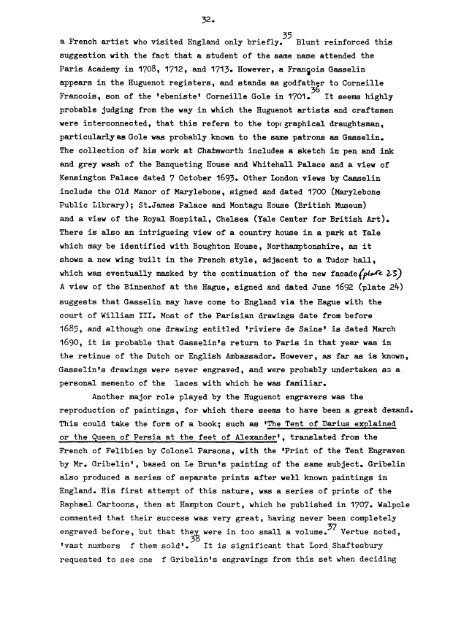HUGIJENOT ARTISTS DESIGNERS AND CRAYPSNEN IN GREAT ...
HUGIJENOT ARTISTS DESIGNERS AND CRAYPSNEN IN GREAT ...
HUGIJENOT ARTISTS DESIGNERS AND CRAYPSNEN IN GREAT ...
Create successful ePaper yourself
Turn your PDF publications into a flip-book with our unique Google optimized e-Paper software.
32.<br />
a French artist who visited England only briefly. Blunt reinforced this<br />
suggestion with the fact that a student of the same name attended the<br />
Paris Academy in 1708, 1712, and 1 713. However, a Franois Gasselin<br />
appears in the Huguenot registers, and stands as godfathr to Corneille<br />
Francois, son of the 'ebeniste' Corneille Gole in 1701. It seems highly<br />
probable judging from the way in which the Huguenot artists and craftsmen<br />
were interconnected, that this refers to the tox graphical draughtaman,<br />
particularly as Gole was probably known to the same patrons as Gasselin.<br />
The collection of his work at Chatsworth includes a sketch in pen and ink<br />
and grey wash of the Banqueting House and Whitehall Palace and a view of<br />
Kensington Palace dated 7 October 1693. Other London views by Canselin<br />
include the Old Manor of Marylebone, signed and dated 1700 (Marylebone<br />
Public Library); St.James Palace and Montagu House (British Museum)<br />
and a view of the Royal Hospital, Chelsea (Yale Center for British Art).<br />
There is also an intrigueing view of a country house in a park at Yale<br />
which may be identified with Boughton House, Northanptonahire, as it<br />
shows a new wing built in the French style, adjacent to a Tudor hail,<br />
which was eventually masked by the continuation of the new facade(p(. d 2)<br />
A view of the Binnenhof at the Hague, signed and dated June 1692 (plate 2k)<br />
suggests that Gasselin may have come to England via the Hague with the<br />
court of William III. Most of the Parisian drawings date from before<br />
1 685, and although one drawing entitled 'riviere de Same' is dated March<br />
1690 , it is probable that Gasselin's return to Paris in that year was in<br />
the retinue of the Dutch or English Ambassador. However, as far as is known,<br />
drawings were never engraved, and were probably undertaken as a<br />
personal memento of the laces with which he was familiar.<br />
Another major role played by the Huguenot engravers was the<br />
reproduction of paintings, for which there seems to have been a great demand.<br />
This could take the form of a book; such as 'The Tent of Darius explained<br />
or the Queen of Persia at the feet of' Alexander', translated from the<br />
French of Felibien by Colonel Parsons, with the 'Print of the Tent Engraven<br />
by Mr. Gribelin', based on Le Brun's painting of the same subject. Gribelin<br />
also produced a series of separate prints after well known paintings in<br />
England. His first attempt of this nature, was a series of prints of the<br />
Raphael Cartoons, then at Hampton Court, which he published in 1707. Walpole<br />
commented that their success was very great, having never been completely<br />
engraved before, but that they were in too small a volume.<br />
37<br />
Vertue noted,<br />
33<br />
'vast numbers f them sold'. It is significant that Lord Shaftesbury<br />
requested to see one f Gribelin's engravings from this set when deciding
















